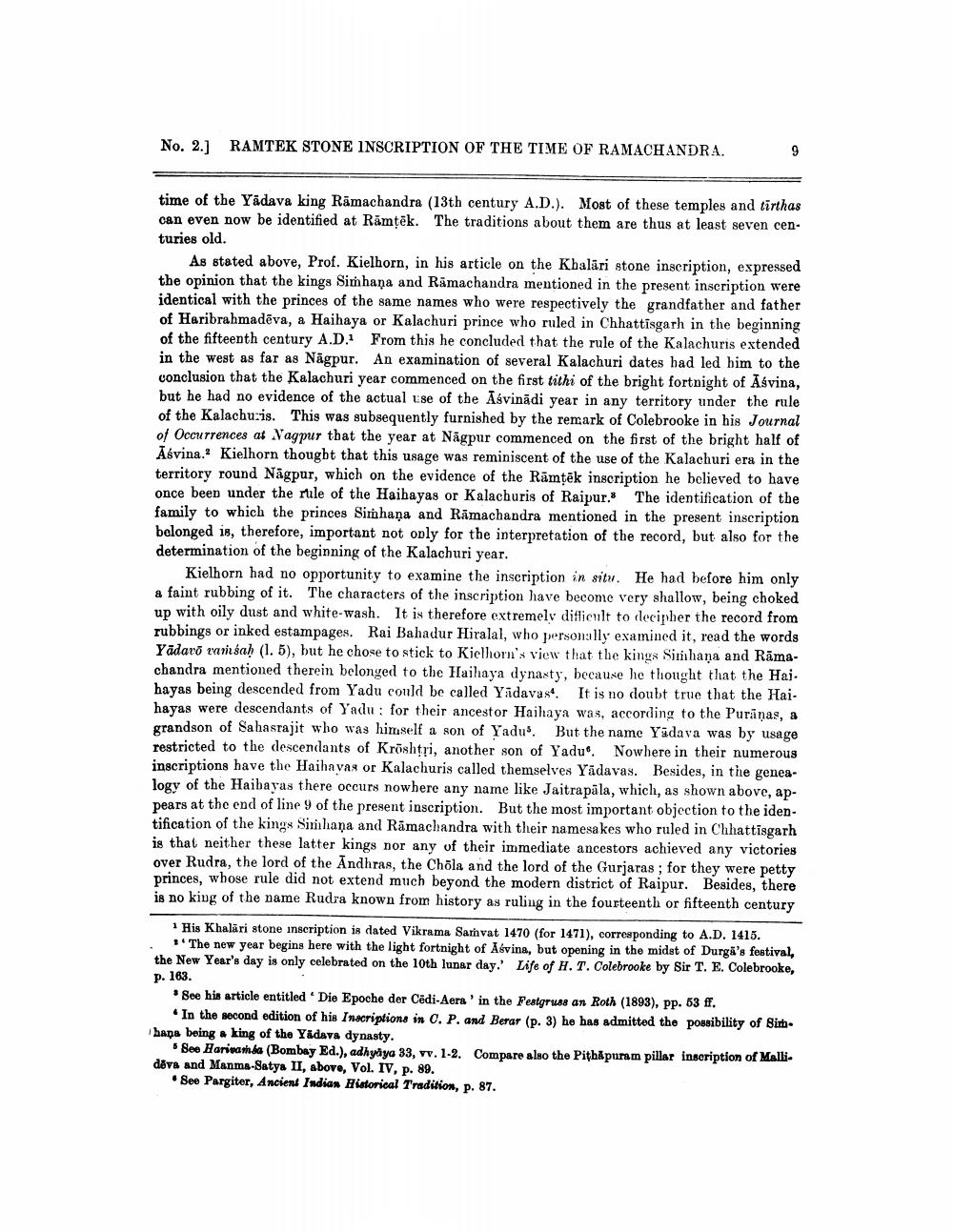________________
No. 2.1 RAMTEK STONE INSCRIPTION OF THE TIME OF RAMACHANDRA.
time of the Yādava king Ramachandra (13th century A.D.). Most of these temples and tirthas can even now be identified at Rämtēk. The traditions about them are thus at least seven centuries old.
As stated above, Prof. Kielhorn, in his article on the Khalari stone inscription, expressed the opinion that the kings Simhaņa and Ramachandra mentioned in the present inscription were identical with the princes of the same names who were respectively the grandfather and father of Haribrahmadēva, a Haihaya or Kalachuri prince who ruled in Chhattisgarh in the beginning of the fifteenth century A.D. From this he concluded that the rule of the Kalachuris extended in the west as far as Nāgpur. An examination of several Kalachuri dates had led him to the conclusion that the Kalachuri year commenced on the first tithi of the bright fortnight of Āśvina, but he had no evidence of the actual use of the Asvinādi year in any territory under the rule of the Kalachuzis. This was subsequently furnished by the remark of Colebrooke in his Journal of Occurrences at Nagpur that the year at Nāgpur commenced on the first of the bright half of Āévina. Kielhorn thought that this usage was reminiscent of the use of the Kalachuri era in the territory round Nagpur, which on the evidence of the Rāmtēk inscription he believed to have once been under the rule of the Haibayas or Kalachuris of Raipur. The identification of the family to which the princes Simhaņa and Ramachandra mentioned in the present inscription belonged is, therefore, important not only for the interpretation of the record, but also for the determination of the beginning of the Kalachuri year.
Kielhorn had no opportunity to examine the inscription in situ. He had before him only a faint rubbing of it. The characters of the inscription have become very shallow, being choked up with oily dust and white-wash. It is therefore extremely difficult to decipher the record from rubbings or inked estampages. Rai Bahadur Hiralal, who personally examined it, read the words Yadaro ramsah (1.5), but he chose to stick to Kielhorn's view that the kings Sinhaņa and Rāmachandra mentioned therein belonged to the Haihaya dynasty, because he thought that the Hai. hayas being descended from Yadu could be called Yadavast. It is no doubt true that the Haihayas were descendants of Yadu: for their ancestor Haihaya was, according to the Purānas, a grandson of Sahasrajit who was himself a son of Yadu. But the name Yadava was by usage restricted to the descendants of Kröshtri, another son of Yadu Nowhere in their numerous inscriptions have the Haihavas or Kalachuris called themselves Yadavas. Besides, in the genealogy of the Haibayas there occurs nowhere any name like Jaitrapāla, which, as shown above, appears at the end of line 9 of the present inscription. But the most important objection to the identification of the kings Simhana and Ramachandra with their namesakes who ruled in Chhattisgarh is that neither these latter kings nor any of their immediate ancestors achieved any victories over Rudra, the lord of the Andhras, the Chola and the lord of the Gurjaras; for they were petty princes, whose rule did not extend much beyond the modern district of Raipur. Besides, there is no king of the name Rudra known from history as ruling in the fourteenth or fifteenth century
His Khalari stone inscription is dated Vikrama Samvat 1470 (for 1471), corresponding to A.D. 1415.
The new year begins here with the light fortnight of Asvina, but opening in the midst of Durga's festival, the New Year's day is only celebrated on the 10th lunar day. Life of H. T. Colebrooke by Sir T. E. Colebrooke, p. 163 * See his article entitled Die Epoche der Cēdi-Aera' in the Festgruss an Roth (1893), pp. 53 ff.
In the second edition of his Inscriptions in O. P. and Berar (p. 3) he has admitted the possibility of Binh bapa being king of the Yadava dynasty.
See Harivasha (Bombay Ed.), adhyaya 33, vv. 1-2. Compare also the Pithapuram pillar inscription of Mallidēva and Manma-Satya II, above, Vol. IV, p. 89.
• See Pargiter, Ancient Indian Historical Tradition, p. 87.




